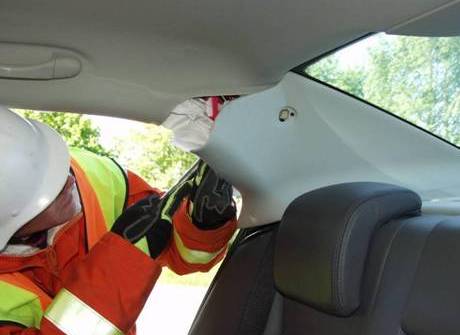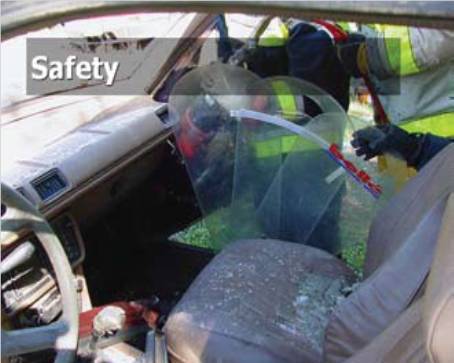 By David Dalrymple
By David Dalrymple
 I have discussed a lot of regarding tasks and tasking before I even mentioned putting tools to the vehicle to create a pathway to disentangle and remove a patient. In this column, I will cover some items directly related to tool evolutions, whether they be displacing or removing vehicle components. As vehicle structures and their inherent materials become more sophisticated, complex, and diverse, we need to look closer at what we are working with today as well as the hazards with which we are dealing. Some of these tasks are taught widely and generally carried out. However, these tasks are not always used, and I will not discuss other tasks here as much as others. Yet, all of these tasks are much more important today than they were in the past. Although I will talk about “prepping” the vehicle, some of these tasks occur during and after patient disentanglement; rescuers tend to give little thought to them as well.
I have discussed a lot of regarding tasks and tasking before I even mentioned putting tools to the vehicle to create a pathway to disentangle and remove a patient. In this column, I will cover some items directly related to tool evolutions, whether they be displacing or removing vehicle components. As vehicle structures and their inherent materials become more sophisticated, complex, and diverse, we need to look closer at what we are working with today as well as the hazards with which we are dealing. Some of these tasks are taught widely and generally carried out. However, these tasks are not always used, and I will not discuss other tasks here as much as others. Yet, all of these tasks are much more important today than they were in the past. Although I will talk about “prepping” the vehicle, some of these tasks occur during and after patient disentanglement; rescuers tend to give little thought to them as well.
 First things first—pull the interior trim whenever you cut into the vehicle’s structure, not just roof posts but anywhere you are severing into its structure, which includes a total side removal (upper and lower B posts) and footwell relief cuts (above). Remember, not only are you looking for SRS cylinders but you can also catch structural reinforcement and alter your cutting technique, angle, or location. Interior trim comes apart easily with a simple prying tool with a thin flat edge that gets between the trim and vehicle body such as a small pry bar or even a screwdriver (never a halligan) (right). And, the trim doesn’t have to come completely off; just open it enough to see behind it well enough where a handlight allows you to see. Remember, when dealing with roof structures and side curtain cylinders, today’s rescuers used to mirror from one side to the other, which is no longer needed because of wheel door setups, which can differ from the driver and passenger sides.
First things first—pull the interior trim whenever you cut into the vehicle’s structure, not just roof posts but anywhere you are severing into its structure, which includes a total side removal (upper and lower B posts) and footwell relief cuts (above). Remember, not only are you looking for SRS cylinders but you can also catch structural reinforcement and alter your cutting technique, angle, or location. Interior trim comes apart easily with a simple prying tool with a thin flat edge that gets between the trim and vehicle body such as a small pry bar or even a screwdriver (never a halligan) (right). And, the trim doesn’t have to come completely off; just open it enough to see behind it well enough where a handlight allows you to see. Remember, when dealing with roof structures and side curtain cylinders, today’s rescuers used to mirror from one side to the other, which is no longer needed because of wheel door setups, which can differ from the driver and passenger sides.
It is a good idea to mark the body with a lumber crayon or (even better) glass chalk that car dealers use. Try to use a bright, obnoxious color.
 Barriers—hard and soft—should be placed between your tool work and the patient and the interior rescuer. The patient needs to be kept warm and protected from the elements, so a, soft pliable barrier such a blanket, an industrial bubble wrap, or even lightweight plastic works here; as long as it is lightweight, breathable, and translucent enough to allow light in (left). This will keep glass and other debris and particles from making direct contact with the patient.
Barriers—hard and soft—should be placed between your tool work and the patient and the interior rescuer. The patient needs to be kept warm and protected from the elements, so a, soft pliable barrier such a blanket, an industrial bubble wrap, or even lightweight plastic works here; as long as it is lightweight, breathable, and translucent enough to allow light in (left). This will keep glass and other debris and particles from making direct contact with the patient.
 Hard protection is also a critical device. Shatter-resistant polycarbonate or lexan material that is cut into various shapes and sizes should be placed between the patient and the interior rescuer to protect them from flying debris (right). Remember, hydraulic power tools can generate more than 200,000 pounds of force, so even plastic bits can have energy when released. It is crucial to always remember that the whole range of advanced/ultra high-strength alloys do not cut cleanly when severed; they fracture, releasing debris that flies around and has energy behind it. In the past, rescuers used short board and long spine board. However, the today’s tight spaces have rendered these items pretty much useless. You need a combination of shatter resistance plus some flexibility to have an effective barrier.
Hard protection is also a critical device. Shatter-resistant polycarbonate or lexan material that is cut into various shapes and sizes should be placed between the patient and the interior rescuer to protect them from flying debris (right). Remember, hydraulic power tools can generate more than 200,000 pounds of force, so even plastic bits can have energy when released. It is crucial to always remember that the whole range of advanced/ultra high-strength alloys do not cut cleanly when severed; they fracture, releasing debris that flies around and has energy behind it. In the past, rescuers used short board and long spine board. However, the today’s tight spaces have rendered these items pretty much useless. You need a combination of shatter resistance plus some flexibility to have an effective barrier.
 Cover up! Yes, with some of the new tools on the market, we now have effective material that can cover sharp edges no matter the weather conditions (left). And, some of these sharp object protections also work extremely well as a glass management tool. Protecto wrap makes a special version of its door/window opening sealant tape called “Extrication Wrap,” which sticks well to vehicle materials (even when wet) and bonds around the sharp edge. The outside has a tyvek covering so it’s very smooth and slick. However, regular Protecto wrap works just as well and can be found in stores such as Lowes and Home Depot. To use it effectively, cut the material into sections and have them ready in a bag or some sort of enclosure.
Cover up! Yes, with some of the new tools on the market, we now have effective material that can cover sharp edges no matter the weather conditions (left). And, some of these sharp object protections also work extremely well as a glass management tool. Protecto wrap makes a special version of its door/window opening sealant tape called “Extrication Wrap,” which sticks well to vehicle materials (even when wet) and bonds around the sharp edge. The outside has a tyvek covering so it’s very smooth and slick. However, regular Protecto wrap works just as well and can be found in stores such as Lowes and Home Depot. To use it effectively, cut the material into sections and have them ready in a bag or some sort of enclosure.
Similarly, ESI Equipment’s PackExe Smash is also used for glass management. However, if you wrap the sharp edge of a roof post, it works like Protecto wrap. PackExe Smash will soon be available soon with a special sharp edge version called Sharps Smash; again, like Protecto wrap, it works in the rain.
Additionally, blanket and roof post covers also work well. These have magnets that stick to the vehicle like hook-and-loop fastener straps which tighten around the cut post. They usually come in bright colors and are washable and reusable. I like to use a combination of both, covering up sharp edges while using the protective blankets to make a clean safe environment for the patient before and during disentanglement.
These might seem like minor details, but they will go along way to protect you as well as the patient. They also build good safe working habits, especially as time marches along and we start to see exotic materials such as various composite materials. And, most of these issues come straight from the vehicle materials. To all the rescuers reading this, I say: You must do these simple tasks to ensure a successful extrication!
DAVID DALRYMPLE is a career EMS provider for the RWJUH Emergency Medical Services in New Brunswick, New Jersey, and a volunteer firefighter/EMT/rescue technician for Clinton (NJ) EMS/Rescue. He has been actively involved with emergency services for 27 years. He is the education chair of the Transportation Emergency Rescue Committee-US (TERC), is a certified international level extrication assessor, and serves on the Expert Technical Advisory Board of the IETRI as their road traffic accident advisor. Certified as a NJ fire service instructor, he has been teaching transportation rescue topics for more than 16 years. He is the executive educator for Roadway Rescue LLC, an educational team for transportation rescue training. He is an ICET (Netherlands) certified registered International SAVER instructor. He writes on “Extrication Tactics“ for Fire Engineering and contributed to Fire Engineering‘s Handbook for Firefighter I and II (2009). He received the 2007 Harvey Grant award for excellence in rescue education. He is featured in “Training Minutes“ on vehicle extrication on fireengineering.com.


